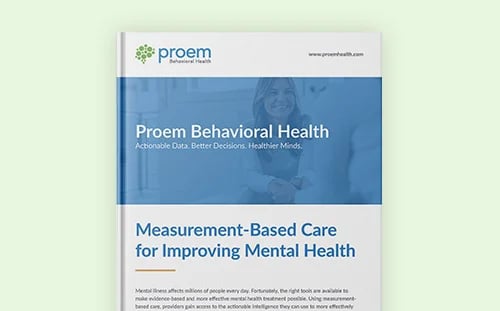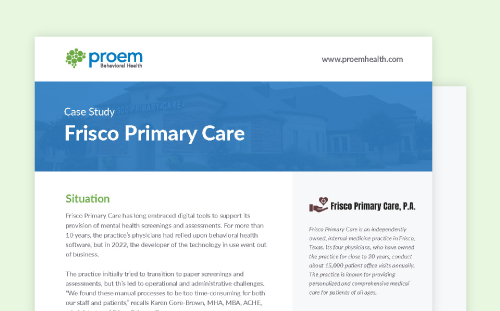A carefully planned substance use disorder (SUD) assessment is essential to the treatment process. Unless the clinical team understands how addiction affects the patient and whether any other co-occurring disorders are at play, developing an effective treatment plan is challenging at best and sometimes impossible.

Clinics must approach intake with a standardized process that uses clinically validated, patient-friendly substance abuse assessments. These assessments should offer a clear view of the patient’s SUD and any co-occurring disorders affecting substance use patterns and treatment needs.
Digital screening and assessment tools make the evaluation process easier and more effective. Consider the following key benefits of using tech-driven methods.
Simplified Integration of Standardized Assessment Tools
According to the Substance Abuse and Mental Health Services Administration (SAMHSA), in-depth assessment for substance abuse is the first step toward an effective treatment plan. It reveals the nature and severity of a patient’s problem, including its effects on various domains of daily life.
The assessment process must also evaluate for co-occurring behavioral health issues. Mental health and addiction affect one another in complex ways, and understanding a person’s mental health status is critical to developing an effective SUD treatment plan.
Digital platforms provide easy access to multiple clinically validated screening tools, including mental health and substance abuse assessments. These platforms smoothly integrate standardized assessments into existing workflows, starting at the intake point and continuing as patients progress through treatment.
Convenient and Comprehensive Recordkeeping
Complete and current patient records are essential to achieving positive behavioral health patient outcomes. Advocates have noted that electronic documentation helps providers offer more integrated treatment, particularly when co-occurring conditions are present.
A digital workflow solution simplifies the process by collecting all information in a single place, which is vital when multiple providers need a comprehensive picture. All authorized users can easily view patient details, including substance use patterns, treatment recommendations and dual diagnosis information. With this data, providers can make correct diagnoses the first time and avoid incorrect, ineffective treatments.
Digital platforms also simplify tracking a patient’s progress over time. They provide a single source for each patient’s treatment records, allowing clinicians treating different disorders to quickly see patterns of recovery or relapse. Such information supports earlier and more proactive decision-making.
Confidential Patient-Provider Communications
Overcoming the stigma around SUD is crucial in the fight for treatment access. Many potential patients struggle with speaking face-to-face with a provider or even admitting they need help.
SAMHSA noted in its Treatment Improvement Protocol that written formats feel less threatening than interviews for many patients. If someone has experienced discrimination or access issues or is concerned about treatment anonymity, they may prefer to complete substance abuse assessments in a digital text format.
Text-based communications serve as a bridge to disclosure. Instead of requiring the patient to look a provider in the eye and admit to problematic substance use, a digital evaluation simply requires the person to check a box or type an answer.
Some patients will be concerned about information security. Any platform used in a clinical setting must conform to the Health Insurance Portability and Accountability Act of 1996 (HIPAA), and providers must be able to provide security information to patients who request it.
Personalized Treatment Plan Management
SUD is a multilayered issue that requires an individualized approach. What works for one patient won’t necessarily work for another, and successful recovery will look different for everyone who struggles with addiction.
Personalization is crucial in patients with co-occurring mental health and substance use disorders. SAMHSA urges clinicians to implement an integrated treatment approach. This approach treats the SUD and mental health disorders concurrently and with an understanding of bidirectional effects.
Integrated treatment also requires a detailed individual plan that includes a coordinated effort among all providers involved in the patient’s treatment. All providers must have access to patient data, and they must be able to adjust treatment documentation and share updated information with patients, colleagues and caregivers.
Digital platforms make recordkeeping easy and accessible. Co-working clinicians can view a substance abuse assessment sample, view patient updated patient records and recommend updates as necessary. These functions foster collaboration and accountability at every level of care, improving treatment delivery and earning patients’ trust.
 Follow Proem Behavioral Health on LinkedIn to help you stay current with the latest behavioral and mental health news.
Follow Proem Behavioral Health on LinkedIn to help you stay current with the latest behavioral and mental health news.
Effective Big-Picture Planning
Digital substance abuse assessments also improve care at the macro level. These tools can aggregate and analyze complex data sets, allowing clinics to identify patterns in their patient populations. Those patterns can reveal critical trends in substance use or identify common patient needs.
For example, as levels of anxiety and depression rise among younger adults, clinics may see more patients under 25 years old with co-occurring conditions. Following aggregated assessment data could offer early signs of a trend, allowing clinics to reallocate resources in advance of a need.
Trend monitoring can also offer insights into patient recovery trajectories, including commonalities among those who relapse. Such connections indicate who might need extra support or monitoring and when. Such preventive interventions could prevent relapse in at-risk patients.
Improve Assessment for Substance Abuse With Proem’s Digital Platform
Digital solutions have the potential to transform care delivery for patients with an SUD. For these solutions to work in a fast-paced clinic setting, they must seamlessly integrate into a practice’s workflow.
Proem’s evidence-based behavioral engine targets the needs of SUD clinics. It puts a wide range of exclusively licensed digital mental health and substance abuse assessments at the providers’ fingertips, allowing for effective, efficient screening at the point of care.
With Proem, providers can simplify the screening and monitoring processes without sacrificing diagnostic accuracy. Providers even receive clinical follow-up suggestions directing them to appropriate resources, so patients get on the right treatment path sooner.
Proem's team is ready to answer questions and provide a substance abuse assessment sample to clinics seeking a better solution. To find out how Proem solutions can help with better SUD outcomes, book a meeting.





.png)









